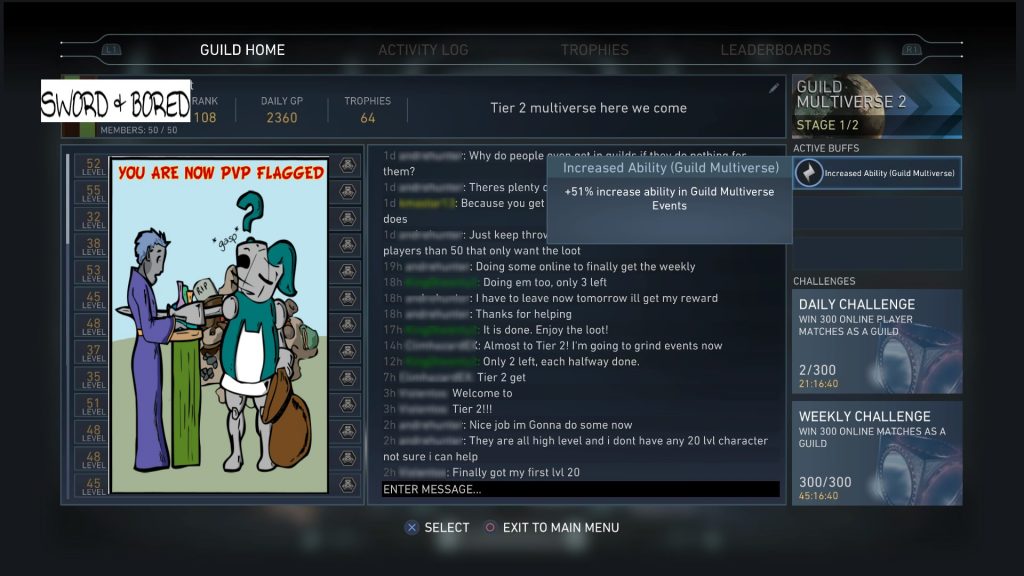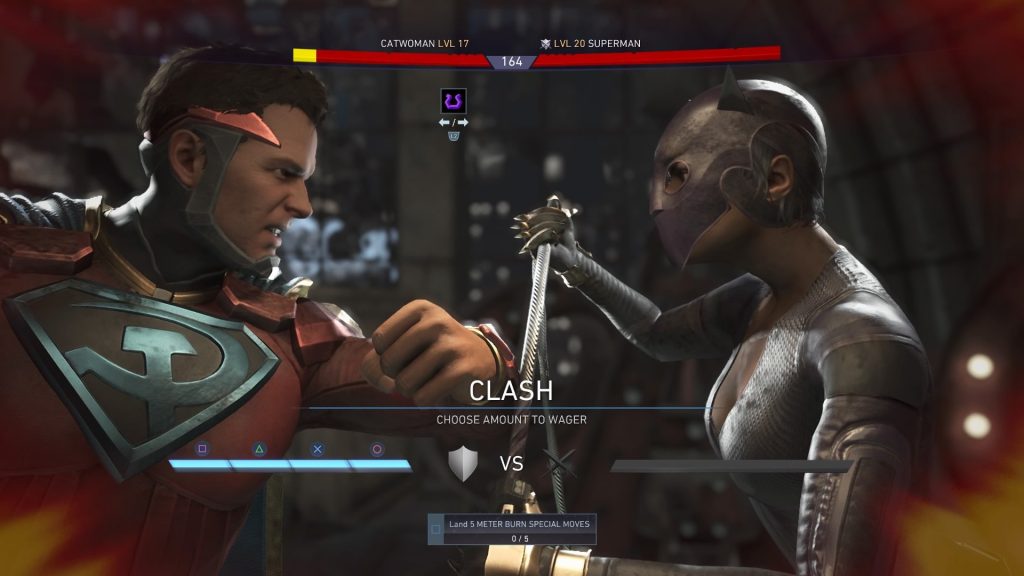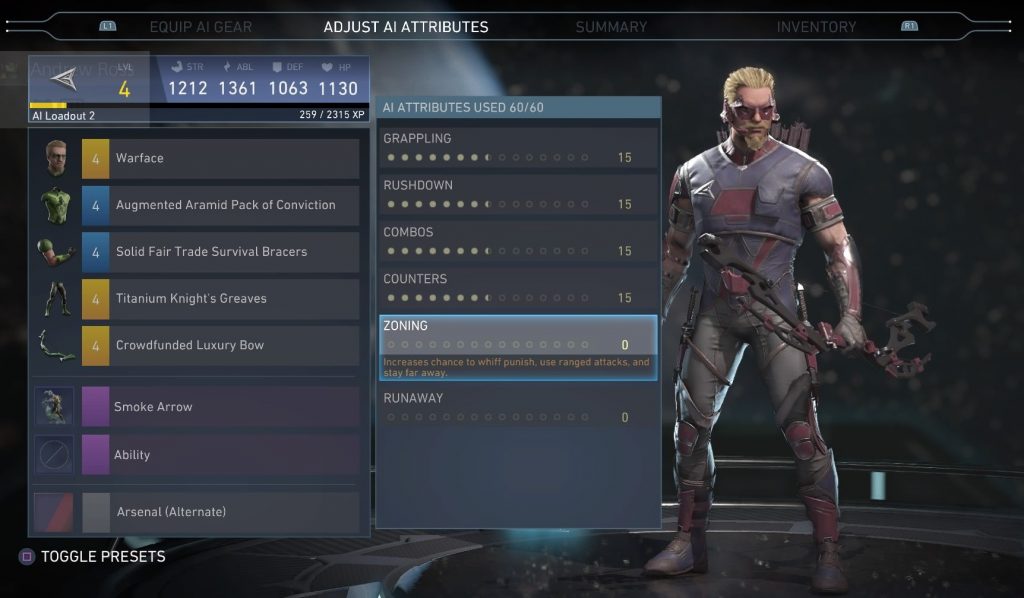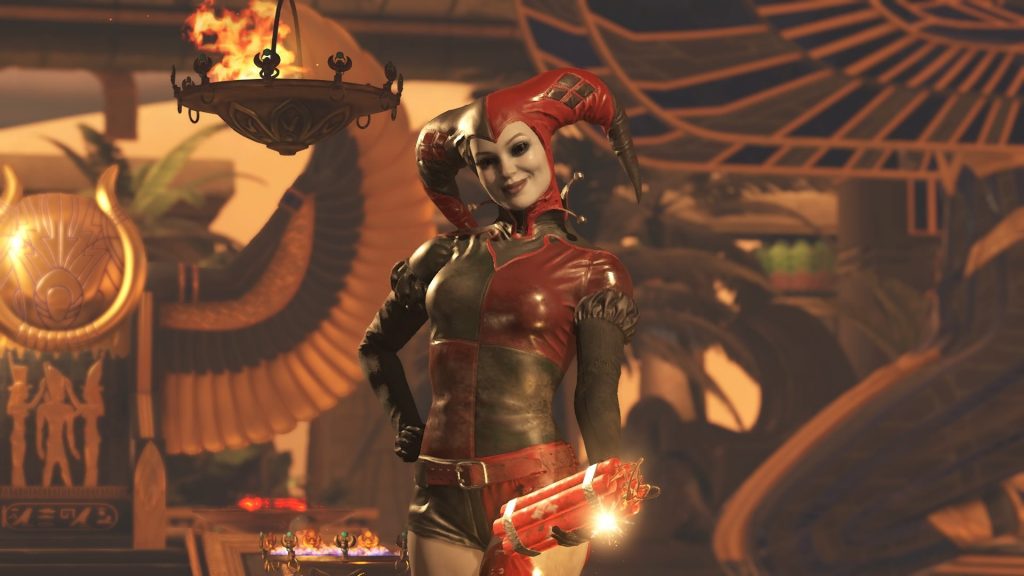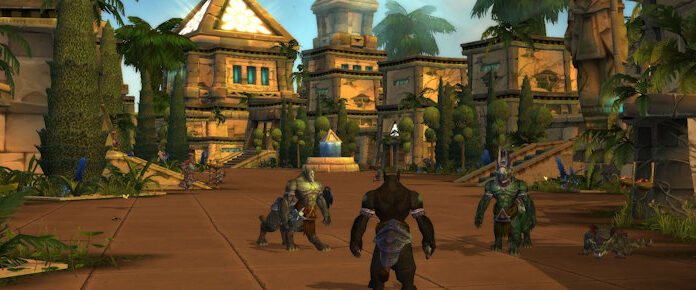
NetherRealms’ Injustice 2 is not an MMORPG. It doesn’t have a persistent world or a massive number of players actively engaging with each other graphically on screen. However, it has levels, character stat and appearance customization, randomly generated loot and boxes, guilds, and boss fights requiring explicit coordination. For the moment, it’s about the most MMO-ish a 2-D fighter has gotten. And my guild experience with the game has shown me the traditionally solo-oriented genre has created a demand for those with a traditional MMO skill set: socialization skills, group planning, and grinding.
All aboard the loot train
Loot alone doesn’t make a game an MMO, but our genre has traditionally been about delving into dungeons and getting randomly generated gear to trick ourselves out with, either for power or social status. While modern MMOs may have focused more on the “best in slot” approach while funneling players into the same routine to execute a perfectly synchronized combat dance, I’m not seeing that in Injustice 2‘s boss fights (yet). Instead, the strength and weakness of guilds is that the loot system is so random that traditional gaming outlets have complained about it.
From an MMO perspective, however, it’s ideal. Not only does dropped loot from actual fights have the option to be biased towards the character you’re playing, but it will be around your character’s level unless you receive it from the story mode, which after you complete certain chapters gives you a max level (20) epic for that character. The loot boxes also aim to give you gear for your level, not based on when you open it but on when you earned it. That means no waiting to a certain level to get your goodies to optimize gear acquisition, just greedily opening boxes as soon as you get your hands on them.
And the gear is really satisfying for a player like me. It’s not just the “+10” strength kind of thing, but weird things like XP bonuses for not jumping, Catwoman “stealing” extra money from fights, or Deadshot’s knee-kick combo suddenly being able to knock opponents out of the ring and into a different level. There are Superman symbols from every era, some awesome takes on Scarecrow’s various masks, plus a rainbow of color combos for Green Lantern to impersonate other lantern corps. Even better are the description texts, which often make references to the character’s personal history, ranging from comic title references to their relationships with other DC characters.
While you may be worried about pairing this with a leveling system, the game also has “Regen Tokens,” which allow you to not only boost an item to your character’s current level but reroll its stats if you like. That means that even if you get a level one epic, you can boost it later on so it stays relevant. The tokens are pretty common too. It’s everything I could want from a superhero loot system, but there is a downside: the transmog system.
Having a transmog system in and of itself is weird for fighting game. Smash Bros is one of the few I know of that lets you equip your fighters, but the only thing you really change is the character’s color (except for the Mii fighters). While it’s really a welcomed addition to Injustice 2, which is already quite a cinematically beautiful fighter to watch, a lot of it is locked behind “source crystals,” a kind of currency used from everything from maxing out characters you don’t want to grind up to unlocking skins.
To put things in perspective, maxing out a character costs 10k source crystals. Skins cost between 4k-6k crystals. A single transmog (one of five equipable slots) costs 2k source crystals. Color changes are free, and the 6k premium skins can’t be visually customized (I really don’t like my Mr. Freeze in shorts), so making your own custom hero is probably going to cost you more than one of those skins. With over 20 active hours with the game and another 20 or so semi-active (more on this later), I’ve gotten fewer than 14k crystals while maxing out five characters. Maybe this is why you’re allowed to buy the crystals for real-life cash, but I figure they help add longevity to the game. After all, what’s an MMO without some kind of loot mechanic helping to fuel social statuses?
The guild system
While it’s cool to have your Boba Fett Batman fighting against someone’s Bizarro Superman, it’s a lot cooler when you have a pool of people to play with watching you build your skin/skill sets. Injustice 2’s group play is extremely limited, almost like a Facebook game for the most part: Guilds have a list of chores to complete during certain periods of time, and most can be done by mass recruiting people who passively play the game.
Where things get complicated is the Guild Multiverse. The Multiverse, in general, is made up of small sets of missions. This can be anything from forcing you to fight as a particular character to following certain rule sets, like no combos or low gravity. Win or lose, you’ll get XP, credits (basic currency), guild credits (if you’re in a guild), and possibly random loot, including the rare crystals. However, the single player Multiverse often has specific rewards, like Epic gear for Batman and another Epic for a random character, while Guild Multiverse rewards are just loot boxes.
Now, Guild Multiverse does have some advantages. If enough people from the guild are active in it, the guild gets buffs while doing missions, making them slightly easier. Not only that, but if the guild moves through the required achievements, everyone gets rewarded, active or inactive, and I’ve heard that the rewards eventually expand to the non-guild Multiverse as well.
Guilds in general have achievements, and meeting those achievements gives boxes to everyone in the guild, active or inactive. The Guild Multiverse, however, is the only place with multiplayer battles. I’ve heard there are bosses with tons of health that can only be whittled down slowly but surely by groups, but the 3vs1 battles are more satisfying. In these, three players go one-on-one with a boss mob. While waiting your turn (or after being defeated and sitting on the bench), you have three cooldowns to use: a projectile attack, a heal, and buff. The latter two are often an item the active fighter has to touch but may also be automatic, like an instant heal or instant super attack (think Fatalities, except the enemy doesn’t have to be dead for you to use them).
It sounds like nothing for an MMO player, but between the two guilds I’ve joined, I’ve realized that perhaps fighting game players just aren’t used to teamwork. For example, I used my projectiles to break people out of combo hell against the AI, but I felt like my allies were just using it to add damage. Even more perplexing, though, was how hard it was just to get two other people to participate.
Perhaps because the guild rewards aren’t shown, a lot of people focus mostly on non-guild quests. Even with the Playstation Network’s out-of-game tools, such as voice chat and a calendar, getting two other players to join me for boss battles was like pulling teeth, and even then, I had officers who didn’t take it seriously, bringing level 5 characters to battles clearly labeled for level 20s after complaining that our members had a lot of freeloaders. After getting a few people motivated, our guild shot up from being one of the thousands of guilds at the bottom to rank 108 (which has fallen since I’ve been too busy to coordinate more guild runs).
Coordination is certainly needed, not just to climb the guild ranks but to get missions done. Yes, a bloated roster with all sorts of people doing things will get people free boxes, but as an old school MMOer, I’ve found it’s much more fun trying to do challenges, pitching in guild credits and gear that needs to be sacrificed to open missions, and motivating people to do boss fight nights.
Getting Into Injustice 2 as an MMOer
Despite not being a pro in the fighting game subgenre, I’m actually not bad at contributing to the guild, and I’m having a lot of fun doing it. Besides my love of loot, the game has an above average story, great voice acting, and is really fun to watch, and I say that as someone who rarely watches streamers, let alone tournaments. There are some good general tips to enjoying the game, but I think approaching this as an MMO fan is a bit different.
I highly suggest playing through the game’s story mode twice to learn the ropes, get cool gear/skins, and to enjoy the cut scenes. There are points in the story when you can choose one fighter or the other, so after you beat the game once, replay it. At level 5 though, join a guild, either a friend’s or a random one. Again, there are a lot of zergy guilds, but playing by yourself does help everyone when a guild is new. A more serious guild will have requirements, so if you’re in a rush, just find one labeled “open” so you can join immediately.
After you’ve gone through the story at least once, jump into the single player multiverse missions. While you can jump into online missions, especially if you’re a Mortal Kombat or Injustice 1 veteran, you should know that not only does the multiverse offer more rewards, but you can pause the game to look at your abilities list.
In the multiverse, you’ll need to go through a tutorial first, but once that’s done, you’ll see the missions are around for only a limited amount of time: some for days, some only a few short hours. There may be level requirements, and there’s nothing you can really do about that at this point.
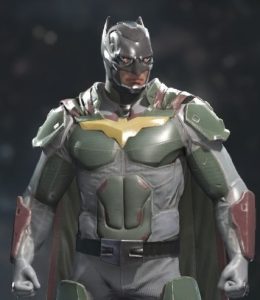 What you want to focus on is getting one character to level 20 so it won’t be such a problem. Choose someone you’re comfortable with. Maybe get a fellow newbie to sit down and play a match or two as each character. That’s the beauty of local multiplayer after all! If you don’t have the patience for that, I’d recommend trying Batman, Superman, Super Girl, Harley Quinn, Blue Beetle, or Black Canary, as they felt easy enough to understand for a dumb button masher like yours truly. Open those loot boxes you got in the Brother Eye vault and customize your character. Come back to those whenever you’ve got boxes and loot. Personally, I prioritized using loot that granted bonus experience to character, if not my profile as well. You can spend credits to get more boxes, but personally, I’m saving my currency to help my guild.
What you want to focus on is getting one character to level 20 so it won’t be such a problem. Choose someone you’re comfortable with. Maybe get a fellow newbie to sit down and play a match or two as each character. That’s the beauty of local multiplayer after all! If you don’t have the patience for that, I’d recommend trying Batman, Superman, Super Girl, Harley Quinn, Blue Beetle, or Black Canary, as they felt easy enough to understand for a dumb button masher like yours truly. Open those loot boxes you got in the Brother Eye vault and customize your character. Come back to those whenever you’ve got boxes and loot. Personally, I prioritized using loot that granted bonus experience to character, if not my profile as well. You can spend credits to get more boxes, but personally, I’m saving my currency to help my guild.
The multiverse (and your daily missions) serve another function though: teaching you to play the game. There will be in-match missions that ask you to do things like execute three bounce attacks or two air escapes. Don’t know how to do something? Pause the game and check your moves list! Having a potential reward in the mix should motivate you to navigate the game’s menus and figure it out. These are skills that translate to all the characters, which is why you want to focus on learning these while taking someone up to the max level.
One of the biggest advantages the game has is its programmable AI, located in the “Customize Characters” section and the bottom two slots of each character. Once you have a good understanding of the basics, you can use the game’s customizable AI to fight for you. Yes, it can be a kind of “game of timers” where you’re just waiting for your AI to get through the multiverse or through an AI Battle Simulator round, but it’s a good way to do your grinding when you want to play but really should be making dinner. However, the AI fighters can’t be used in guild missions or any direct fights with other players, like the online modes. The AI fighters are also how you can get past tough bosses your twitch skills can’t carry you through and maybe learn a combo or two.
That being said, I don’t think a new player should jump into AI grinding from the start. Setting Deadshot to Rush and Combo priority is a mistake you wouldn’t make if you’d played with or against him and realized he’s much better at zoning. That’s why you should choose a character you like and get them to the cap, 20, first. The basics are important. From there, you can just grind characters to the cap, focus on the gear grind, whatever. But with a level 20 character, you should be able to actually start helping your guild.
While simply doing the guild missions is beneficial, the best thing an MMO player can do is communicate with his or her guild. If you’ve led a raid or an event in an MMO, this will be much simpler: suggest a time, day, and activity. Then, at that time, do it.
Boss fights are the easiest to coordinate because they require an invite to activate and people don’t seem to want to solo them (it’s an option, but a rough one in my opinion). You can just invite everyone online and once two other people join, it’ll start the actual fight.
Although boss fights are only made for a few people, they’re unique enough to pique people’s interest. You’d be surprised how effective it is to have someone giving time zones for meets or updating the guild on how close you are to certain achievements. I may not have done a lot of damage in the boss fights I did, but I was able to get people to think differently about them, all while motivating people to help be trick out my Harley Quinn.
 Are you burned out on MMOs? It happens. But there are plenty of other titles out there with open worlds, progression, RPG mechanics, and other MMO stalwarts. Massively OP’s MMO Burnout turns a critical eye toward everything from AAA blockbusters to obscure indie gems.
Are you burned out on MMOs? It happens. But there are plenty of other titles out there with open worlds, progression, RPG mechanics, and other MMO stalwarts. Massively OP’s MMO Burnout turns a critical eye toward everything from AAA blockbusters to obscure indie gems.

